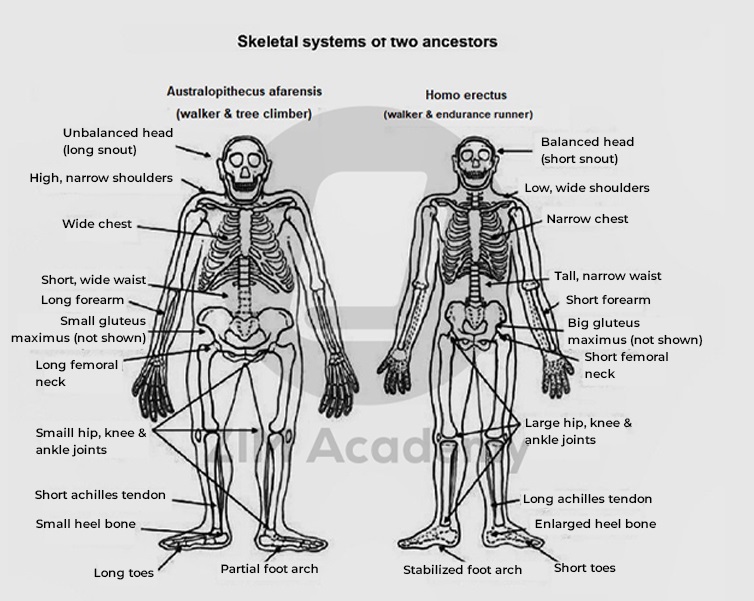Bài mẫu IELTS Writing Task 1 “Lạ – Khó” | Phần 6
Xem thêm: Bài mẫu IELTS Writing Task 1 “Lạ – Khó” | Phần 5
Đề bài IELTS Writing Task 1 – 06
The diagram shows the skeletal systems of two ancestors of humen beings
Summarise the information by selecting and reporting the main features and make comparisons where relevant.
Phân tích tổng quan
Dạng bài: Diagram
Đối tượng đề cập trong bài: So sánh cấu trúc xương của hai tổ tiên loài người
Đơn vị đo lường: không có
Thì sử dụng: Cả hai loài này đều đã tuyệt chủng trong lịch sử nên sử dụng thì quá khứ đơn cho toàn bộ bài viết
Lời khuyên
Khi xử lý dạng bài Task 1 theo biểu đồ có hình ảnh, người viết cũng chú trọng vào các nhiệm vụ chính của task 1 như các dạng khác là mô tả, so sánh, và tổng hợp thông tin. Người viết cần tổng hợp các đặc điểm của các bộ phận có trong hình để so sánh đối chiếu với chức năng của chúng.
Dàn bài
Mở bài | Giới thiệu nội dung hình vẽ (so sánh cấu trúc xương hai tổ tiên của loài người) |
Đoạn tổng quát (Overview) | Vì quen với đi bộ và leo trèo nên xương của Australopithecus afarensis to hơn xương của Homo erectus |
Thân bài 1 | Miêu tả nửa thân trên:
|
Thân bài 2 | Miêu tả nửa thân dưới:
⇒ Bàn chân vững, chắc hơn so với Australopithecus afarensis |
Bài mẫu tham khảo
The diagram illustrates the bone structures of two ancestors of modern humans, namely Australopithecus afarensis and Homo erectus. Overall, used to walking and climbing trees, the former had much larger bones than the latter, who often walked and ran long-distance.
On the upper half of the body, with a broader chest and waist, the appearance of Australopithecus afarensis was rounder than Homo erectus. The same can be said for their heads, yet the head of Homo erectus was more balanced. However, the shoulders of Homo erectus were wider and lower. Moving on to the arms, while Australopithecus afarensis had long forearms in order to climb trees more easily, Homo erectus developed shorter ones.
Regarding the other half of the body, the system of Homo erectus was suited for endurance running, with a shorter femoral neck, longer legs and larger hip, knees and ankle joints. In addition, the feet of Homo erectus were also smaller, with shorter toes, larger heel bone and longer Achilles tendon, which created a stabilized foot arch, compared to a partial one of Australopithecus afarensis.
Từ vựng
Upper half of the body: nửa thân trên
Be suited for: phù hợp với.. (chức năng nào đó)
Các cấu trúc câu thể hiện sự so sánh:
The same can be said for their heads, yet the head of Homo erectus was more balanced.
Moving on to the arms, while Australopithecus afarensis had long forearms in order to climb trees more easily, Homo erectus developed shorter ones.
…. a stabilized foot arch, compared to a partial one of Australopithecus afarensis.
Xem thêm: Tổng hợp bài mẫu IELTS Writing 2024

Bình luận - Hỏi đáp